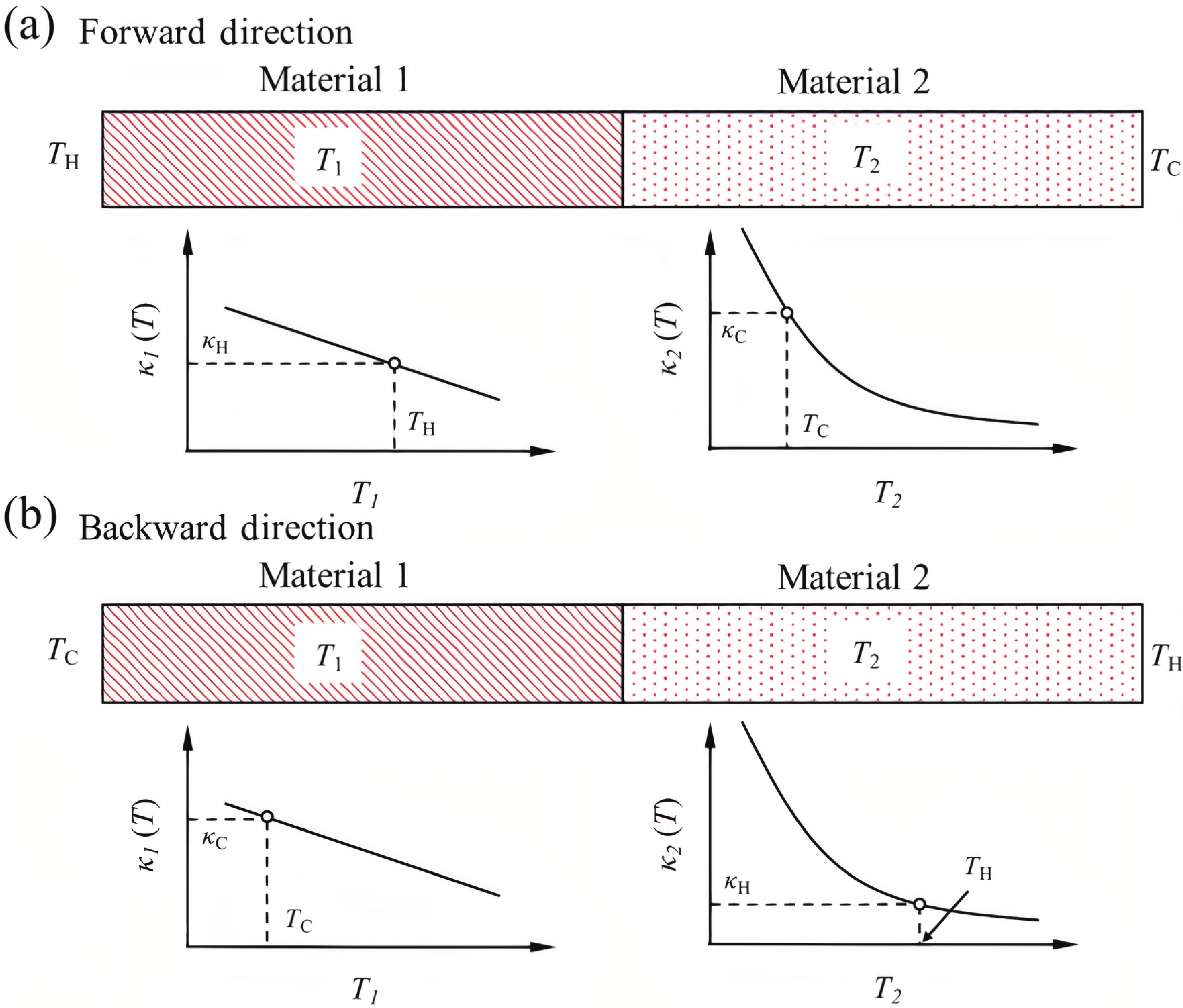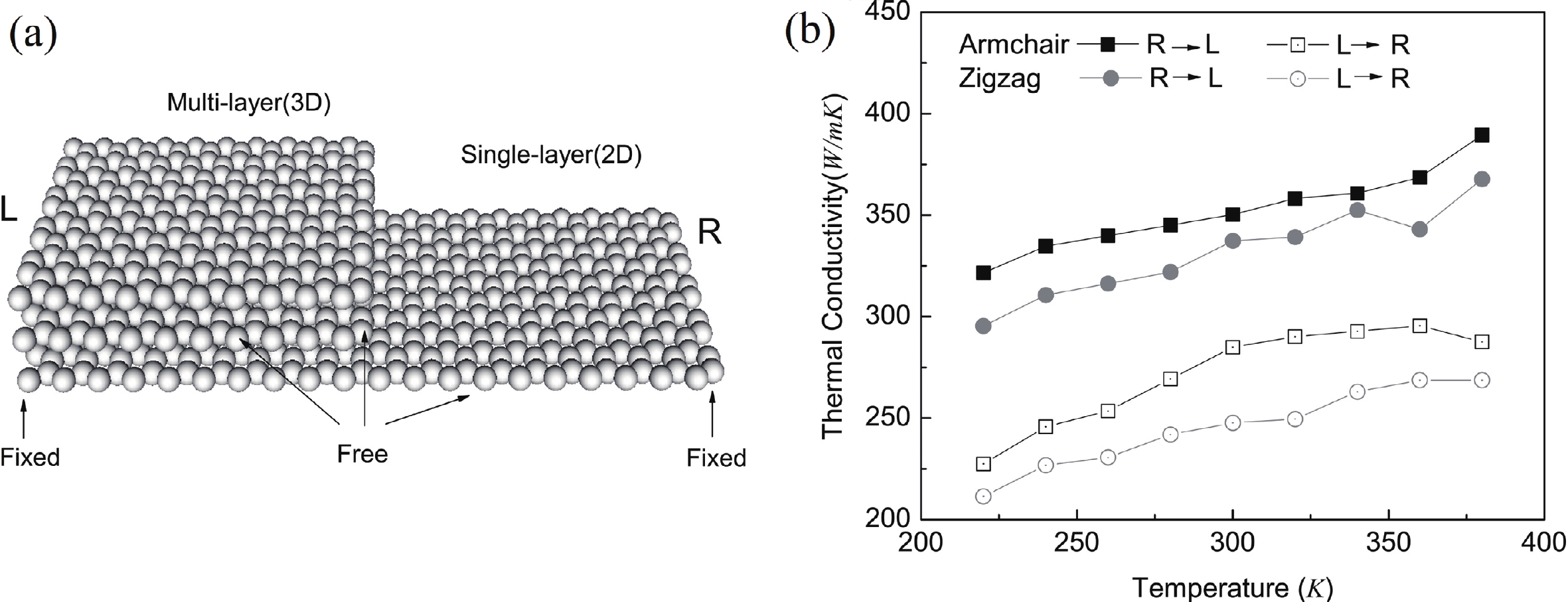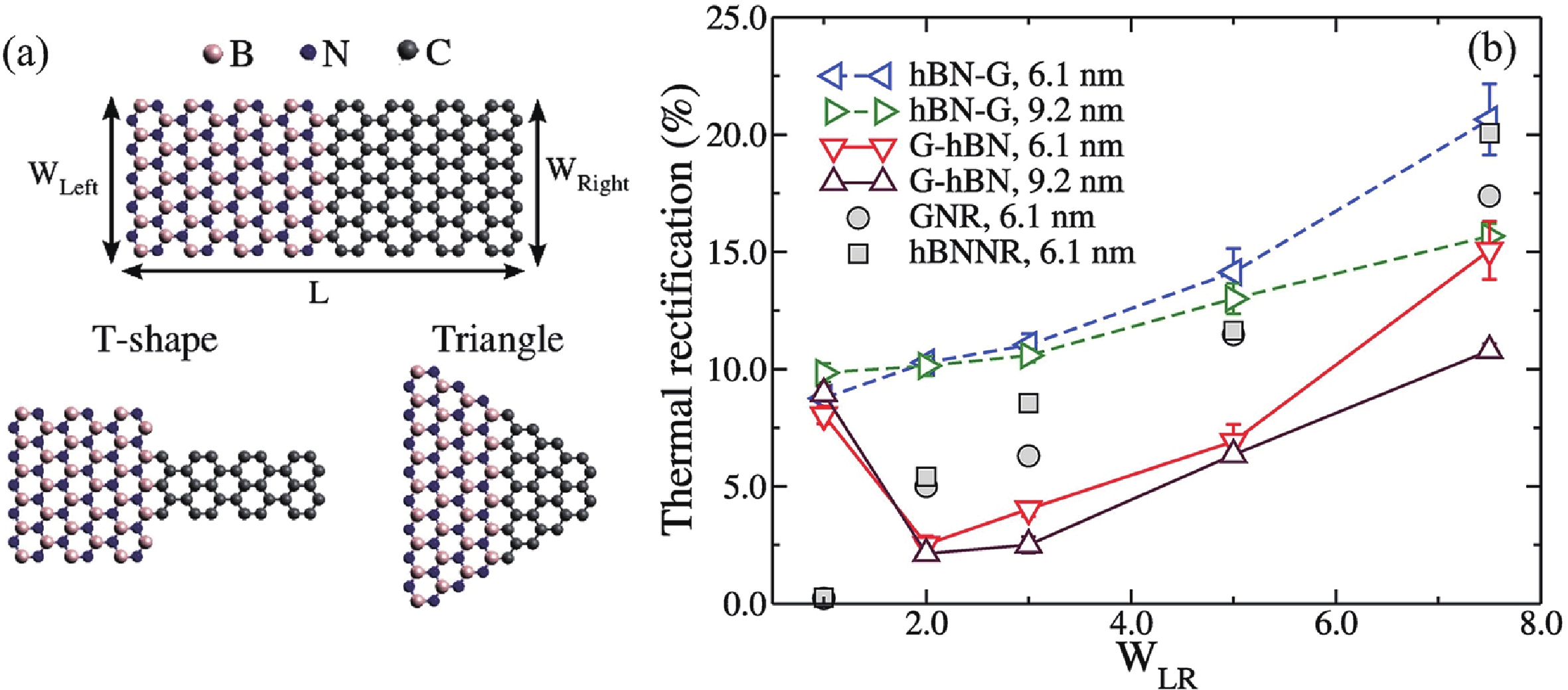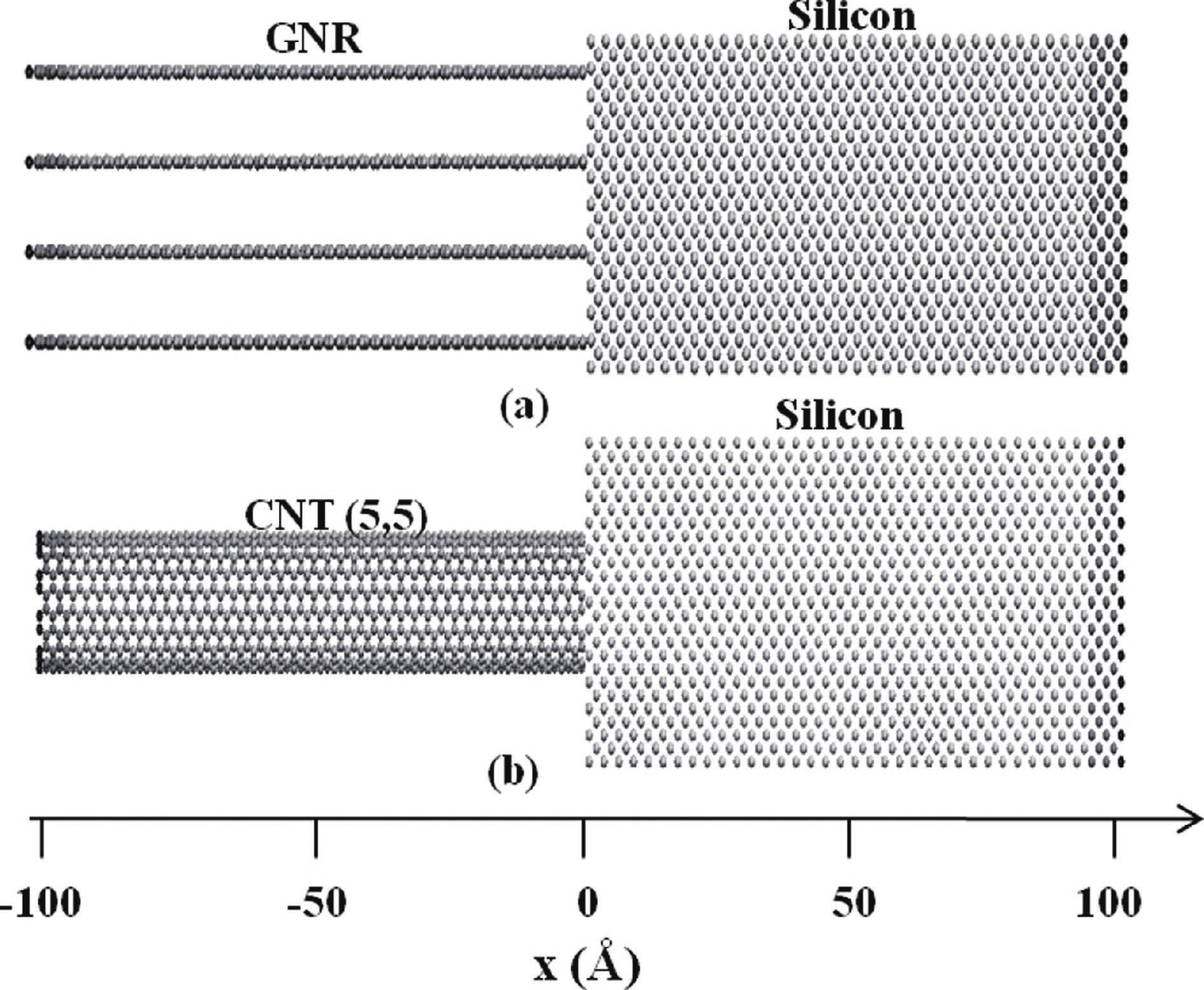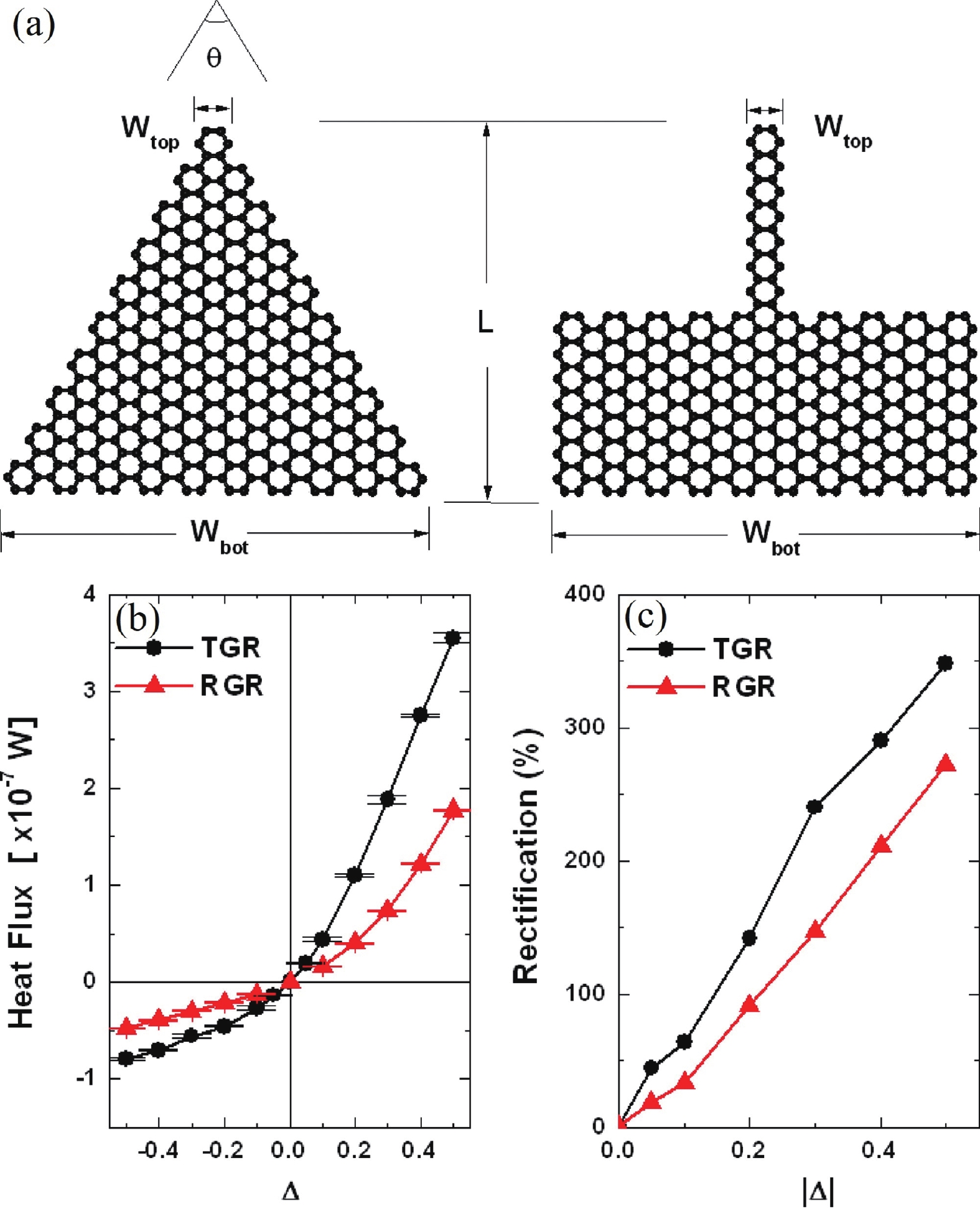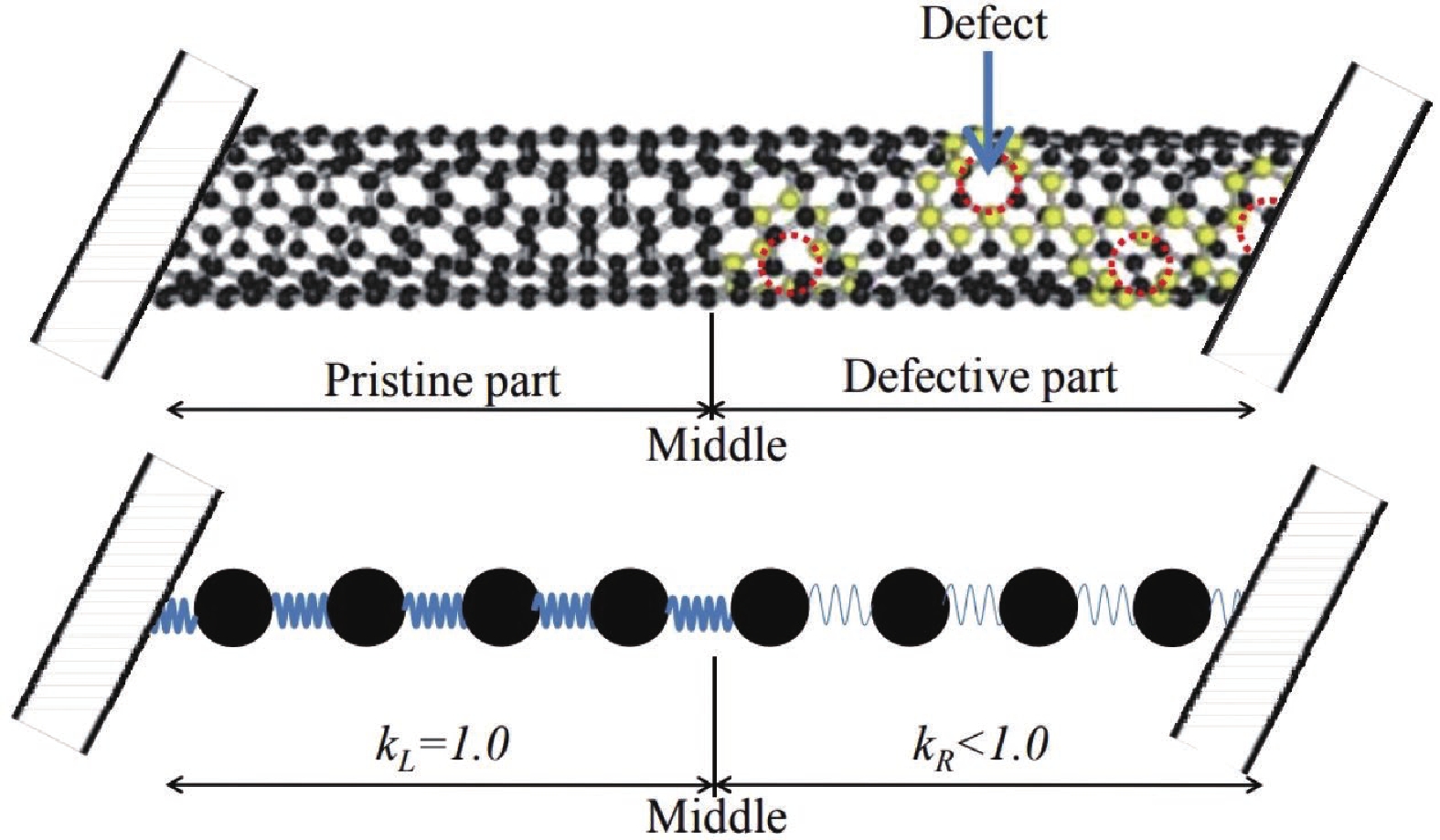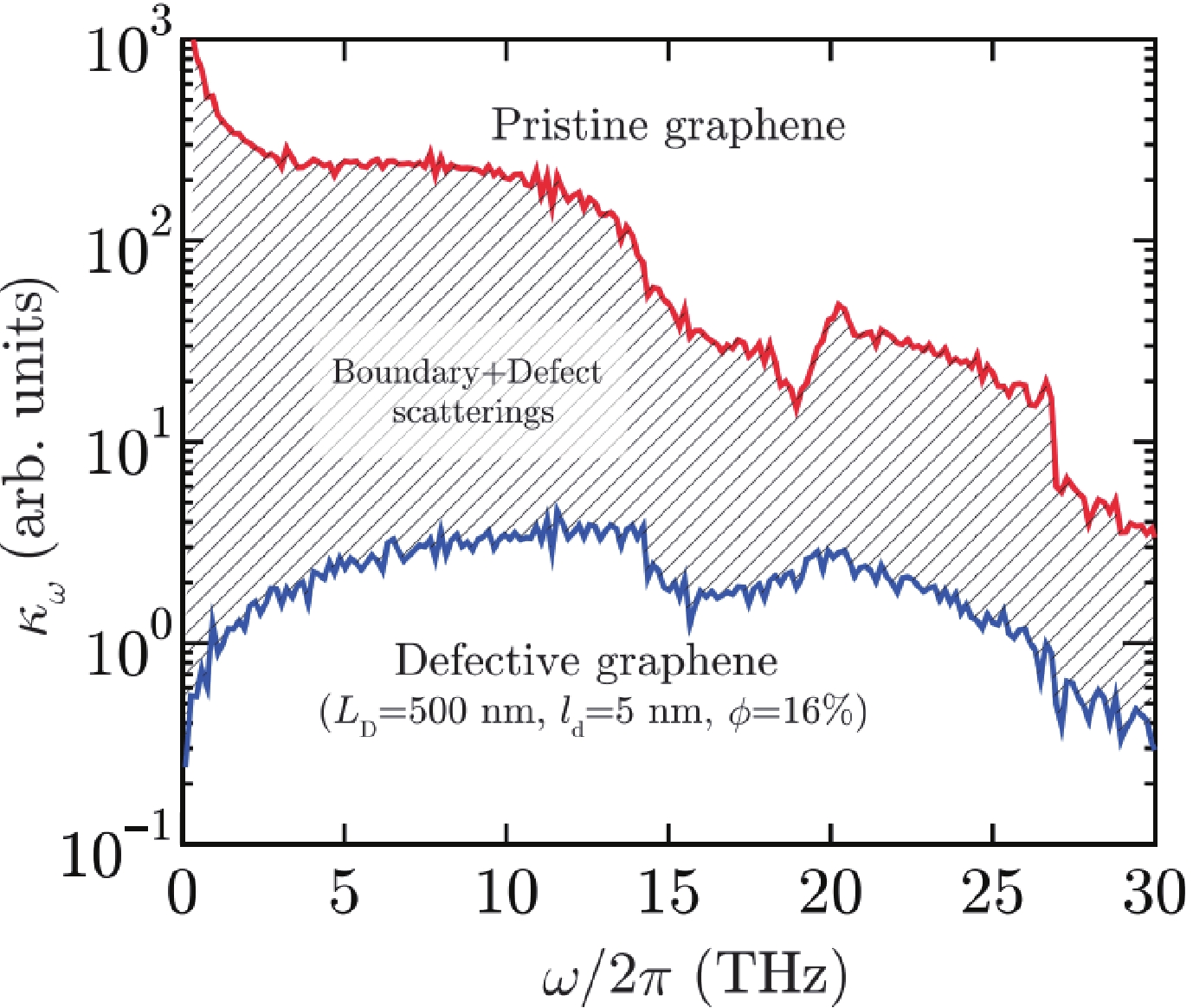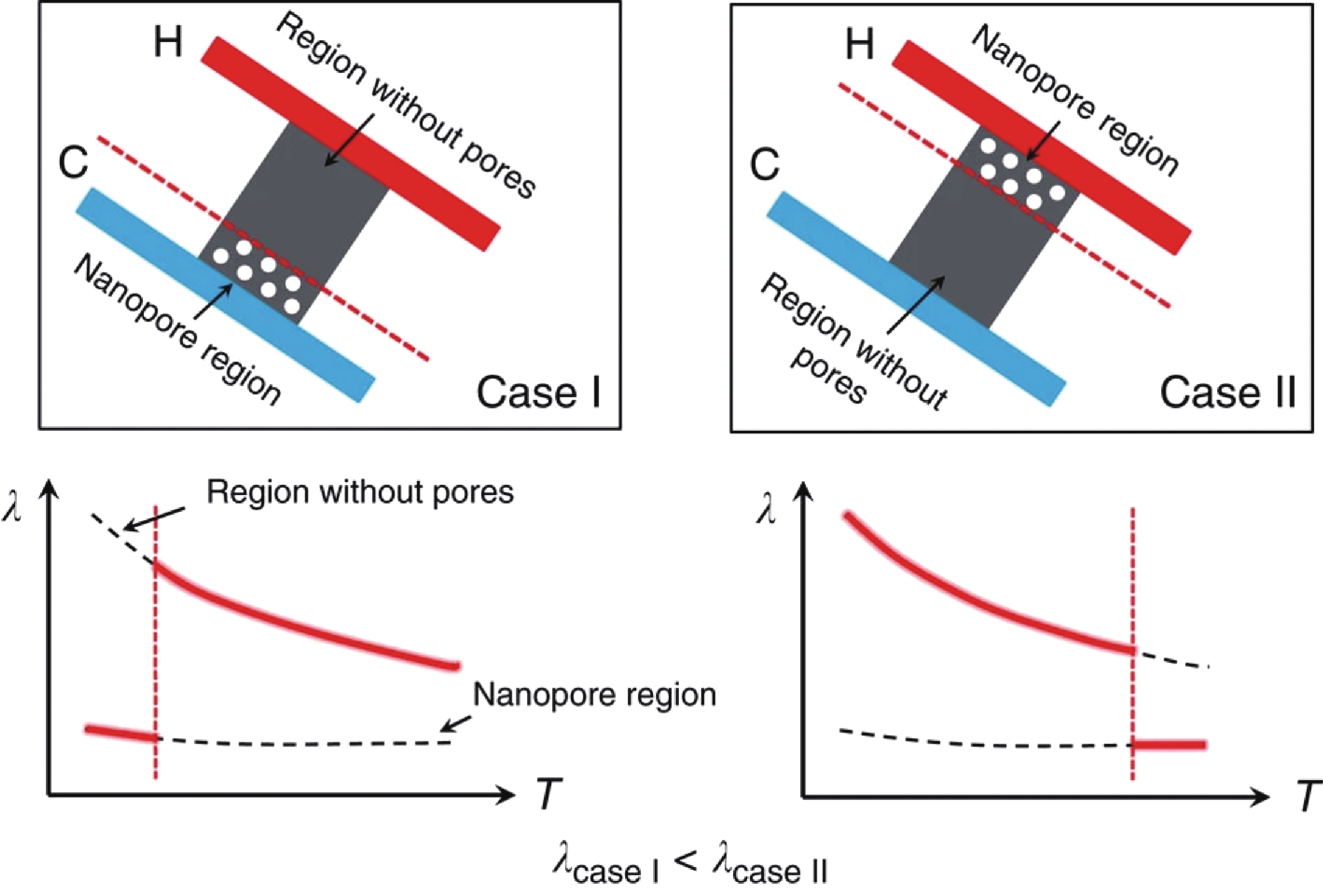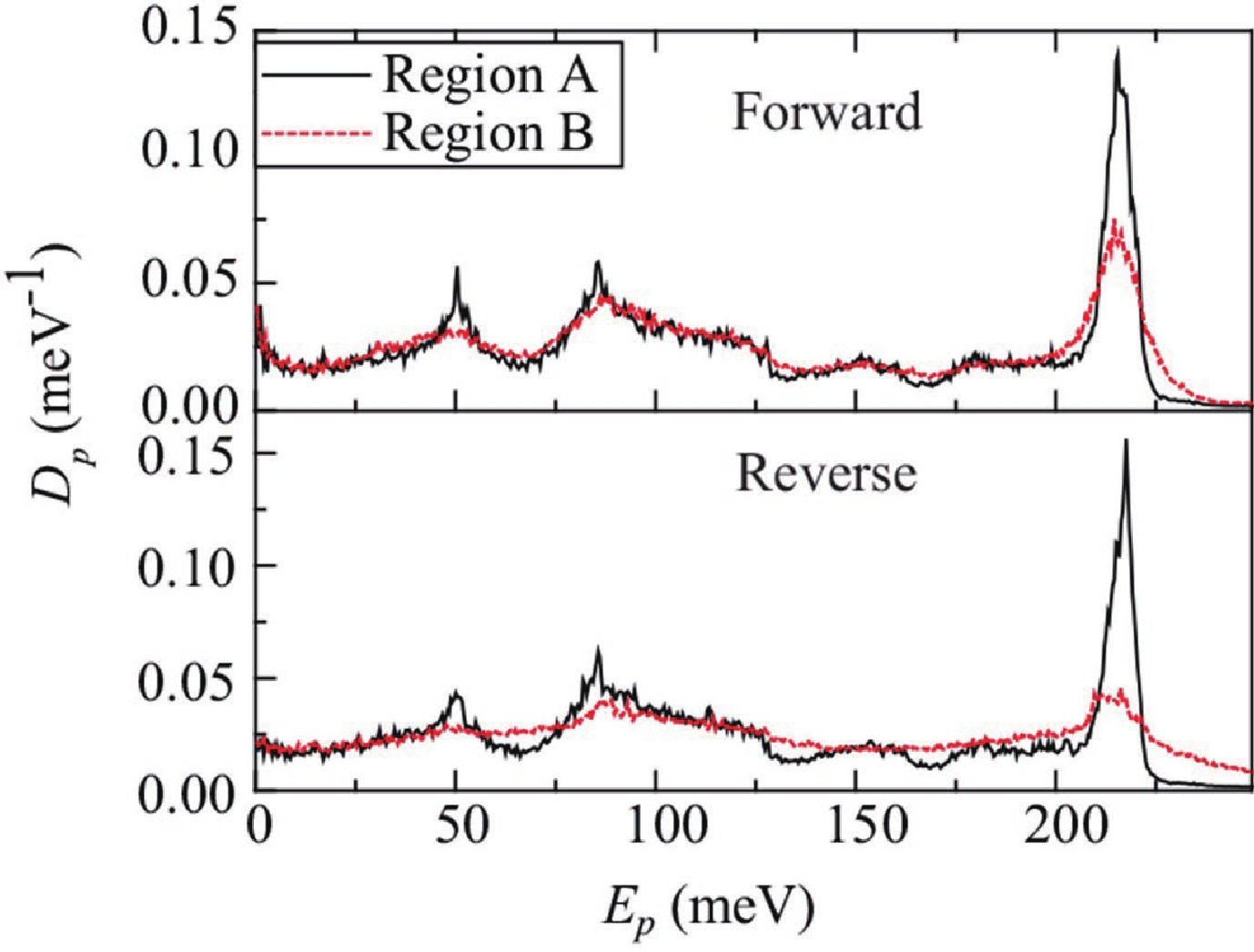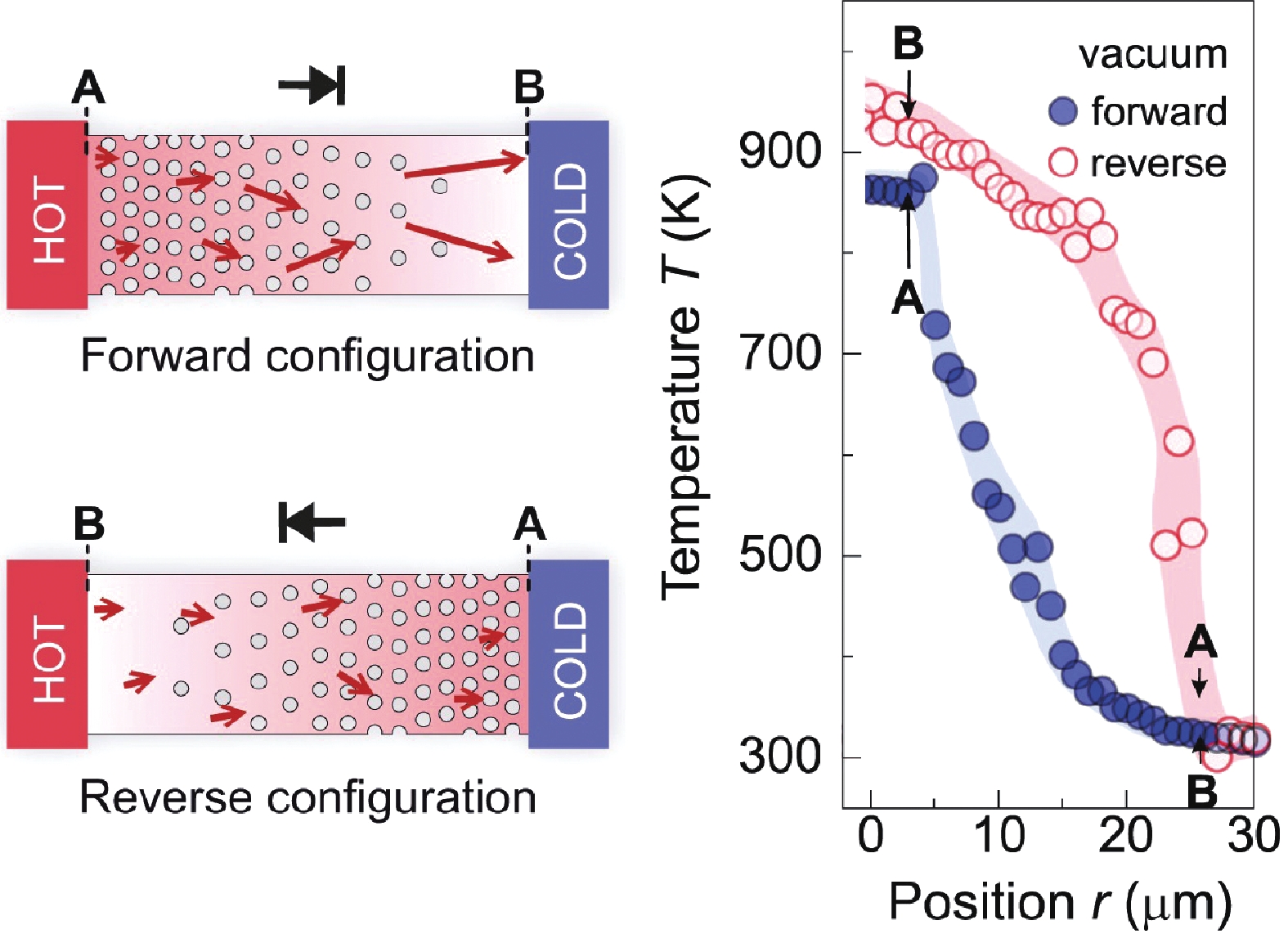| Citation: |
Faraz Kaiser Malik, Kristel Fobelets. A review of thermal rectification in solid-state devices[J]. Journal of Semiconductors, 2022, 43(10): 103101. doi: 10.1088/1674-4926/43/10/103101
****
F K Malik, K Fobelets. A review of thermal rectification in solid-state devices[J]. J. Semicond, 2022, 43(10): 103101. doi: 10.1088/1674-4926/43/10/103101
|
A review of thermal rectification in solid-state devices
DOI: 10.1088/1674-4926/43/10/103101
More Information
-
Abstract
Thermal rectification, or the asymmetric transport of heat along a structure, has recently been investigated as a potential solution to the thermal management issues that accompany the miniaturization of electronic devices. Applications of this concept in thermal logic circuits analogous to existing electronics-based processor logic have also been proposed. This review highlights some of the techniques that have been recently investigated for their potential to induce asymmetric thermal conductivity in solid-state structures that are composed of materials of interest to the electronics industry. These rectification approaches are compared in terms of their quantitative performance, as well as the range of practical applications that they would be best suited to. Techniques applicable to a range of length scales, from the continuum regime to quantum dots, are discussed, and where available, experimental findings that build upon numerical simulations or analytical predictions are also highlighted.-
Keywords:
- thermal rectification,
- joule heating,
- solid-state devices
-
References
[1] Thompson S E, Parthasarathy S. Moore's law: The future of Si microelectronics. Mater Today, 2006, 9, 20 doi: 10.1016/S1369-7021(06)71539-5[2] Cardoso J M P, Coutinho J G F, Diniz P C. High-performance embedded computing. In: Embedded Computing for High Performance, Amsterdam: Elsevier, 2017, 17[3] Pop E. Energy dissipation and transport in nanoscale devices. Nano Res, 2010, 3, 147 doi: 10.1007/s12274-010-1019-z[4] Malik F K, Talha T, Ahmed F. A parametric study of the effects of critical design parameters on the performance of nanoscale silicon devices. Nanomaterials, 2020, 10, 1987 doi: 10.3390/nano10101987[5] Vasileska D, Raleva K, Goodnick S M. Modeling heating effects in nanoscale devices: The present and the future. J Comput Electron, 2008, 7, 66 doi: 10.1007/s10825-008-0254-y[6] Choi J, Jeong M. Compact, lightweight, and highly efficient circular heat sink design for high-end PCs. Appl Therm Eng, 2016, 92, 162 doi: 10.1016/j.applthermaleng.2015.09.096[7] Sohel Murshed S M, Nieto de Castro C A. A critical review of traditional and emerging techniques and fluids for electronics cooling. Renew Sustain Energy Rev, 2017, 78, 821 doi: 10.1016/j.rser.2017.04.112[8] Roberts N A, Walker D G. A review of thermal rectification observations and models in solid materials. Int J Therm Sci, 2011, 50, 648 doi: 10.1016/j.ijthermalsci.2010.12.004[9] Wong M Y, Tso C Y, Ho T C, et al. A review of state of the art thermal diodes and their potential applications. Int J Heat Mass Transf, 2021, 164, 120607 doi: 10.1016/j.ijheatmasstransfer.2020.120607[10] Chiu C L, Wu C H, Huang B W, et al. Detecting thermal rectification. AIP Adv, 2016, 6, 121901 doi: 10.1063/1.4968613[11] Chakraborty D, Brooke J, Hulse N C S, et al. Thermal rectification optimization in nanoporous Si using Monte Carlo simulations. J Appl Phys, 2019, 126, 184303 doi: 10.1063/1.5119806[12] Thompson A P, Aktulga H M, Berger R, et al. LAMMPS - a flexible simulation tool for particle-based materials modeling at the atomic, meso, and continuum scales. Comput Phys Commun, 2022, 271, 108171 doi: 10.1016/j.cpc.2021.108171[13] Medrano Sandonas L, Cuba-Supanta G, Gutierrez R, et al. Enhancement of thermal transport properties of asymmetric graphene/hBN nanoribbon heterojunctions by substrate engineering. Carbon, 2017, 124, 642 doi: 10.1016/j.carbon.2017.09.025[14] Wehmeyer G, Yabuki T, Monachon C, et al. Thermal diodes, regulators, and switches: Physical mechanisms and potential applications. Appl Phys Rev, 2017, 4, 041304 doi: 10.1063/1.5001072[15] Starr C. The copper oxide rectifier. Physics, 1936, 7, 15 doi: 10.1063/1.1745338[16] Chen X K, Xie Z X, Zhang Y, et al. Highly efficient thermal rectification in carbon/boron nitride heteronanotubes. Carbon, 2019, 148, 532 doi: 10.1016/j.carbon.2019.03.073[17] Li S, Guo Z X, Ding J W. Interface thermal transport of graphene-based intralayer heterostructures. Phys B, 2019, 561, 164 doi: 10.1016/j.physb.2019.02.064[18] Giazotto F, Bergeret F S. Thermal rectification of electrons in hybrid normal metal-superconductor nanojunctions. Appl Phys Lett, 2013, 103, 242602 doi: 10.1063/1.4846375[19] Wang H D, Hu S Q, Takahashi K, et al. Experimental study of thermal rectification in suspended monolayer graphene. Nat Commun, 2017, 8, 15843 doi: 10.1038/ncomms15843[20] Bahk J H, Bian Z X, Shakouri A. Electron energy filtering by a nonplanar potential to enhance the thermoelectric power factor in bulk materials. Phys Rev B, 2013, 87, 075204 doi: 10.1103/PhysRevB.87.075204[21] Sierra M A, Sánchez D. Strongly nonlinear thermovoltage and heat dissipation in interacting quantum dots. Phys Rev B, 2014, 90, 115313 doi: 10.1103/PhysRevB.90.115313[22] Huberman, Overhauser. Electronic Kapitza conductance at a diamond-Pb interface. Phys Rev B, 1994, 50, 2865 doi: 10.1103/physrevb.50.2865[23] Sergeev A V. Electronic Kapitza conductance due to inelastic electron-boundary scattering. Phys Rev B, 1998, 58, R10199 doi: 10.1103/PhysRevB.58.R10199[24] Majumdar A, Reddy P. Role of electron-phonon coupling in thermal conductance of metal-nonmetal interfaces. Appl Phys Lett, 2004, 84, 4768 doi: 10.1063/1.1758301[25] Walker D. Thermal rectification mechanisms including noncontinuum effects. Proc Jt ASME ISHMT Heat Transf, 2006[26] Mahan G D. Thermionic refrigeration. J Appl Phys, 1994, 76, 4362 doi: 10.1063/1.357324[27] Rogers G F C. Heat transfer at the interface of dissimilar metals. Int J Heat Mass Transf, 1961, 2, 150 doi: 10.1016/0017-9310(61)90022-9[28] Moon J S, Keeler R N. A theoretical consideration of directional effects in heat flow at the interface of dissimilar metals. Int J Heat Mass Transf, 1962, 5, 967 doi: 10.1016/0017-9310(62)90076-5[29] Crossno J, Shi J K, Wang K, et al. Observation of the Dirac fluid and the breakdown of the Wiedemann-Franz law in graphene. Science, 2016, 351, 1058 doi: 10.1126/science.aad0343[30] Martínez-Pérez M J, Giazotto F. Efficient phase-tunable Josephson thermal rectifier. Appl Phys Lett, 2013, 102, 182602 doi: 10.1063/1.4804550[31] Martínez-Pérez M J, Fornieri A, Giazotto F. Rectification of electronic heat current by a hybrid thermal diode. Nat Nanotechnol, 2015, 10, 303 doi: 10.1038/nnano.2015.11[32] Breunig D, Zhang S B, Trauzettel B, et al. Directional electron filtering at a superconductor-semiconductor interface. Phys Rev B, 2021, 103, 165414 doi: 10.1103/PhysRevB.103.165414[33] Staring A A M, Molenkamp L W, Alphenaar B W, et al. Coulomb-blockade oscillations in the thermopower of a quantum dot. Europhys Lett, 1993, 22, 57 doi: 10.1209/0295-5075/22/1/011[34] Scheibner R, König M, Reuter D, et al. Quantum dot as thermal rectifier. New J Phys, 2008, 10, 083016 doi: 10.1088/1367-2630/10/8/083016[35] Kuo D M T, Chang Y C. Thermoelectric and thermal rectification properties of quantum dot junctions. Phys Rev B, 2010, 81, 205321 doi: 10.1103/PhysRevB.81.205321[36] Zhang Y C, Su S H. Thermal rectification and negative differential thermal conductance based on a parallel-coupled double quantum-dot. Physica A, 2021, 584, 126347 doi: 10.1016/j.physa.2021.126347[37] Peyrard M. The design of a thermal rectifier. Europhys Lett, 2006, 76, 49 doi: 10.1209/epl/i2006-10223-5[38] Terraneo M, Peyrard M, Casati G. Controlling the energy flow in nonlinear lattices: A model for a thermal rectifier. Phys Rev Lett, 2002, 88, 094302 doi: 10.1103/PhysRevLett.88.094302[39] Li B W, Lan J H, Wang L. Interface thermal resistance between dissimilar anharmonic lattices. Phys Rev Lett, 2005, 95, 104302 doi: 10.1103/PhysRevLett.95.104302[40] Hu M, Keblinski P, Li B W. Thermal rectification at silicon-amorphous polyethylene interface. Appl Phys Lett, 2008, 92, 211908 doi: 10.1063/1.2937834[41] Kobayashi W, Teraoka Y, Terasaki I. An oxide thermal rectifier. Appl Phys Lett, 2009, 95, 171905 doi: 10.1063/1.3253712[42] Arora A, Hori T, Shiga T, et al. Thermal rectification in restructured graphene with locally modulated temperature dependence of thermal conductivity. Phys Rev B, 2017, 96, 165419 doi: 10.1103/PhysRevB.96.165419[43] Cottrill A L, Strano M S. Analysis of thermal diodes enabled by junctions of phase change materials. Adv Energy Mater, 2015, 5, 1500921 doi: 10.1002/aenm.201500921[44] Dames C. Solid-state thermal rectification with existing bulk materials. J Heat Transf, 2009, 131, 1 doi: 10.1115/1.3089552[45] Ordonez-Miranda J, Hill J M, Joulain K, et al. Conductive thermal diode based on the thermal hysteresis of VO2 and nitinol. J Appl Phys, 2018, 123, 085102 doi: 10.1063/1.5019854[46] Pallecchi E, Chen Z, Fernandes G E, et al. A thermal diode and novel implementation in a phase-change material. Mater Horiz, 2015, 2, 125 doi: 10.1039/C4MH00193A[47] Cottrill A L, Wang S, Liu A T, et al. Dual phase change thermal diodes for enhanced rectification ratios: Theory and experiment. Adv Energy Mater, 2018, 8, 1702692 doi: 10.1002/aenm.201702692[48] Hirata K, Matsunaga T, Singh S, et al. High-performance solid-state thermal diode consisting of Ag2(S, Se, Te). J Electron Mater, 2020, 49, 2895 doi: 10.1007/s11664-020-07964-8[49] Kasali S O, Ordonez-Miranda J, Joulain K. Conductive thermal diode based on two phase-change materials. Int J Therm Sci, 2020, 153, 106393 doi: 10.1016/j.ijthermalsci.2020.106393[50] Chaves A, Azadani J G, Alsalman H, et al. Bandgap engineering of two-dimensional semiconductor materials. npj 2D Mater Appl, 2020, 4, 29 doi: 10.1038/s41699-020-00162-4[51] Chen X K, Pang M, Chen T, et al. Thermal rectification in asymmetric graphene/hexagonal boron nitride van der waals heterostructures. ACS Appl Mater Interfaces, 2020, 12, 15517 doi: 10.1021/acsami.9b22498[52] Farzadian O, Razeghiyadaki A, Spitas C, et al. Phonon thermal rectification in hybrid graphene-C3N: A molecular dynamics simulation. Nanotechnology, 2020, 31, 485401 doi: 10.1088/1361-6528/abb04b[53] Wang H, Liu F C, Fu W, et al. Two-dimensional heterostructures: Fabrication, characterization, and application. Nanoscale, 2014, 6, 12250 doi: 10.1039/C4NR03435J[54] Liu B, Baimova J A, Reddy C D, et al. Interface thermal conductance and rectification in hybrid graphene/silicene monolayer. Carbon, 2014, 79, 236 doi: 10.1016/j.carbon.2014.07.064[55] Rajabpour A, Bazrafshan S, Volz S. Carbon-nitride 2D nanostructures: Thermal conductivity and interfacial thermal conductance with the silica substrate. Phys Chem Chem Phys, 2019, 21, 2507 doi: 10.1039/C8CP06992A[56] Zhong W R, Huang W H, Deng X R, et al. Thermal rectification in thickness-asymmetric graphene nanoribbons. Appl Phys Lett, 2011, 99, 193104 doi: 10.1063/1.3659474[57] Yousefi F, Khoeini F, Rajabpour A. Thermal rectification and interfacial thermal resistance in hybrid pillared-graphene and graphene: A molecular dynamics and continuum approach. Nanotechnology, 2020, 31, 285707 doi: 10.1088/1361-6528/ab8420[58] Cao H Y, Xiang H J, Gong X G. Unexpected large thermal rectification in asymmetric grain boundary of graphene. Solid State Commun, 2012, 152, 1807 doi: 10.1016/j.ssc.2012.07.013[59] Yamada M, Yamakita Y, Ohno K. Phonon dispersions of hydrogenated and dehydrogenated carbon nanoribbons. Phys Rev B, 2008, 77, 054302 doi: 10.1103/PhysRevB.77.054302[60] Yamamoto T, Watanabe K, Mii K. Empirical-potential study of phonon transport in graphitic ribbons. Phys Rev B, 2004, 70, 245402 doi: 10.1103/PhysRevB.70.245402[61] Vallabhaneni A K, Qiu B, Hu J N, et al. Interfacial thermal conductance limit and thermal rectification across vertical carbon nanotube/graphene nanoribbon-silicon interfaces. J Appl Phys, 2013, 113, 064311 doi: 10.1063/1.4790367[62] Li T, Tang Z N, Huang Z X, et al. Interfacial thermal resistance of 2D and 1D carbon/hexagonal boron nitride van der Waals heterostructures. Carbon, 2016, 105, 566 doi: 10.1016/j.carbon.2016.05.001[63] Lee S H, Choi M S, Lee J, et al. High performance vertical tunneling diodes using graphene/hexagonal boron nitride/graphene hetero-structure. Appl Phys Lett, 2014, 104, 053103 doi: 10.1063/1.4863840[64] Chen C C, Li Z, Shi L, et al. Thermoelectric transport across graphene/hexagonal boron nitride/graphene heterostructures. Nano Res, 2015, 8, 666 doi: 10.1007/s12274-014-0550-8[65] Kim E, Yu T H, Song E S, et al. Chemical vapor deposition-assembled graphene field-effect transistor on hexagonal boron nitride. Appl Phys Lett, 2011, 98, 262103 doi: 10.1063/1.3604012[66] Bui K, Nguyen H, Cousin C, et al. Thermal behavior of double-walled carbon nanotubes and evidence of thermal rectification. J Phys Chem C, 2012, 116, 4449 doi: 10.1021/jp2107878[67] Chang C W, Okawa D, Majumdar A, et al. Solid-state thermal rectifier. Science, 2006, 314, 1121 doi: 10.1126/science.1132898[68] Desmarchelier P, Tanguy A, Termentzidis K. Thermal rectification in asymmetric two-phase nanowires. Phys Rev B, 2021, 103, 014202 doi: 10.1103/PhysRevB.103.014202[69] Yang N, Zhang G, Li B W. Thermal rectification in asymmetric graphene ribbons. Appl Phys Lett, 2009, 95, 033107 doi: 10.1063/1.3183587[70] Hu J N, Ruan X L, Chen Y P. Thermal conductivity and thermal rectification in graphene nanoribbons: A molecular dynamics study. Nano Lett, 2009, 9, 2730 doi: 10.1021/nl901231s[71] Wang Y, Vallabhaneni A, Hu J N, et al. Phonon lateral confinement enables thermal rectification in asymmetric single-material nanostructures. Nano Lett, 2014, 14, 592 doi: 10.1021/nl403773f[72] Medrano Sandonas L, Gutierrez R, Dianat A, et al. Engineering thermal rectification in MoS2 nanoribbons: A non-equilibrium molecular dynamics study. RSC Adv, 2015, 5, 54345 doi: 10.1039/C5RA05733G[73] Yang X, Zheng X H, Liu Q S, et al. Experimental study on thermal conductivity and rectification in suspended monolayer MoS2. ACS Appl Mater Interfaces, 2020, 12, 28306 doi: 10.1021/acsami.0c07544[74] Han C L, Chen Z Q, Li B W. Thermal rectification in three dimensional graphite nanocones. Int J Heat Mass Transf, 2021, 179, 121675 doi: 10.1016/j.ijheatmasstransfer.2021.121675[75] Miller J, Jang W, Dames C. Thermal rectification by ballistic phonons in asymmetric nanostructures. Proceedings of ASME 2009 Heat Transfer Summer Conference, 2010, 317[76] Hayashi H, Ito Y, Takahashi K. Thermal rectification of asymmetrically-defective materials. J Mech Sci Technol, 2011, 25, 27 doi: 10.1007/s12206-010-1008-x[77] Li B W, Wang L, Casati G. Thermal diode: Rectification of heat flux. Phys Rev Lett, 2004, 93, 184301 doi: 10.1103/PhysRevLett.93.184301[78] Yousefzadi Nobakht A, Ashraf Gandomi Y, Wang J Q, et al. Thermal rectification via asymmetric structural defects in graphene. Carbon, 2018, 132, 565 doi: 10.1016/j.carbon.2018.02.087[79] Hu S Q, Chen J, Yang N, et al. Thermal transport in graphene with defect and doping: Phonon modes analysis. Carbon, 2017, 116, 139 doi: 10.1016/j.carbon.2017.01.089[80] Yousefi F, Khoeini F, Rajabpour A. Thermal conductivity and thermal rectification of nanoporous graphene: A molecular dynamics simulation. Int J Heat Mass Transf, 2020, 146, 118884 doi: 10.1016/j.ijheatmasstransfer.2019.118884[81] Zhao W W, Wang Y L, Wu Z T, et al. Defect-engineered heat transport in graphene: A route to high efficient thermal rectification. Sci Rep, 2015, 5, 11962 doi: 10.1038/srep11962[82] Kasprzak M, Sledzinska M, Zaleski K, et al. High-temperature silicon thermal diode and switch. Nano Energy, 2020, 78, 105261 doi: 10.1016/j.nanoen.2020.105261 -
Proportional views





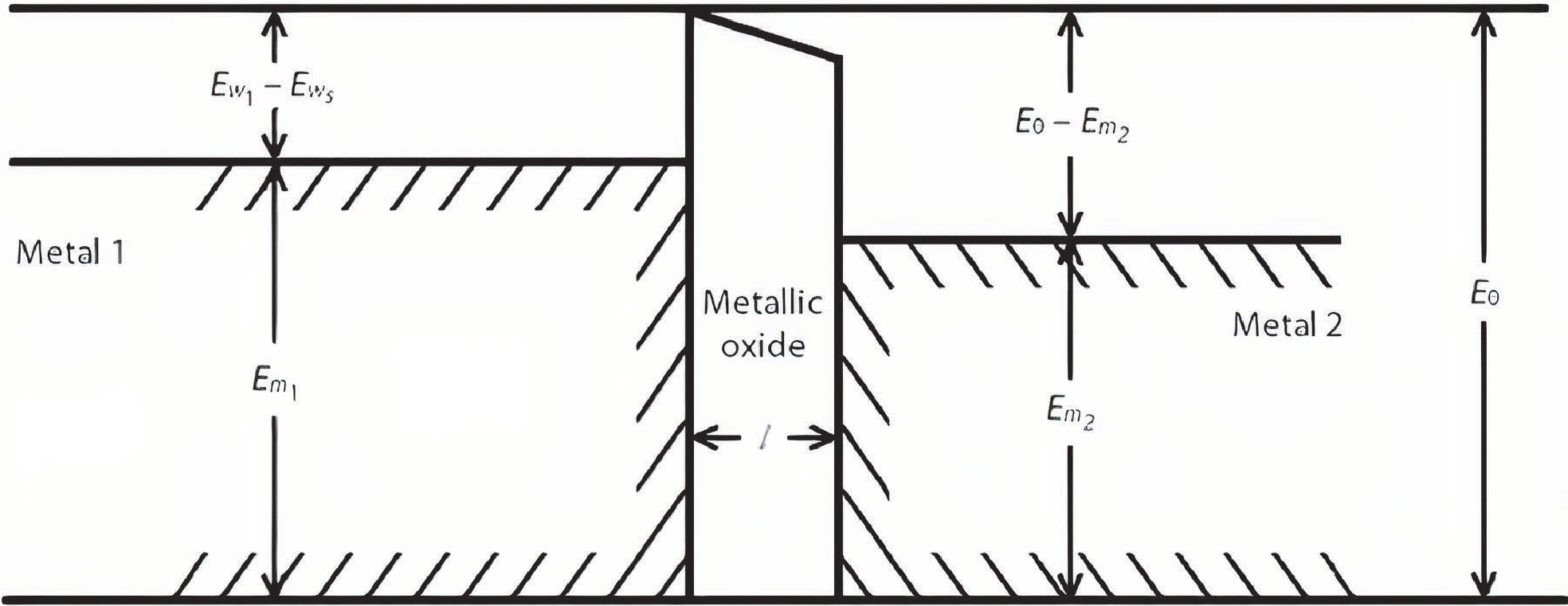



 DownLoad:
DownLoad:
